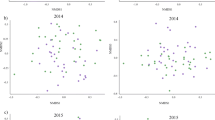Abstract
The relationship between plant diversity and productivity has received much attention in ecology, but the relationship of these factors to soil microbial communities has been little explored. The carbon resources that support soil microbial communities are primarily derived from plants, so it is likely that the soil microbial community should respond to changes in plant diversity or productivity, particularly if the plant community affects the quality or quantity of available carbon. We investigated the relationship of plant diversity and productivity to the composition of the soil microbial community along a topographic gradient in a mid-successional old-field in southwestern Michigan. Soil moisture, soil inorganic N, and plant biomass increased from the top to the base of the slope, while light at ground level decreased along this same gradient. We characterized the changes in resource levels along this gradient using an index of productivity that incorporated light levels, soil N, soil moisture, and plant biomass. Average plant species richness declined with this productivity index and there were associated compositional changes in the plant community along the gradient. The plant community shifted from predominantly low-growing perennial forbs at low productivities to perennial grasses at higher productivities. Although there was variation in the structure of the soil microbial community [as indicated by fatty acid methyl ester (FAME) profiles], changes in the composition of the soil microbial community were not correlated with plant productivity or diversity. However, microbial activity [as indicated by Biolog average well color development and substrate-induced respiration (SIR)] was positively correlated with plant productivity. The similarity between patterns of plant biomass and soil microbial activity suggests that either plant productivity is driving microbial productivity or that limiting resources for each of these two communities co-vary.
Similar content being viewed by others
Author information
Authors and Affiliations
Additional information
Electronic Publication
Rights and permissions
About this article
Cite this article
Broughton, L., Gross, K. Patterns of diversity in plant and soil microbial communities along a productivity gradient in a Michigan old-field. Oecologia 125, 420–427 (2000). https://doi.org/10.1007/s004420000456
Received:
Accepted:
Published:
Issue Date:
DOI: https://doi.org/10.1007/s004420000456




